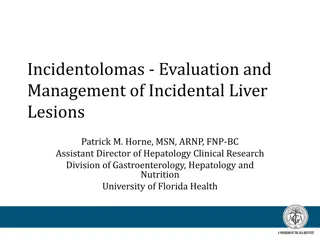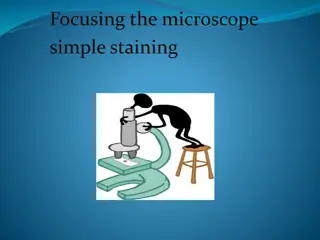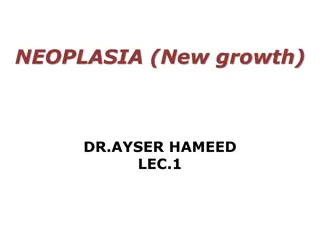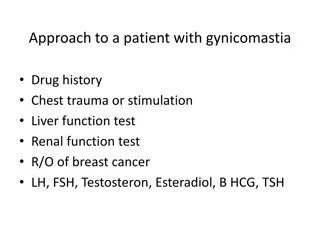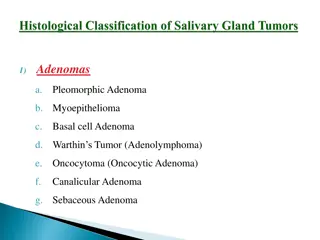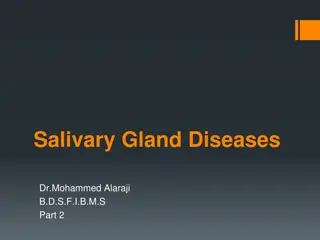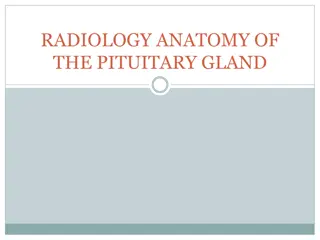
Pleomorphic Adenoma in Salivary Glands
Learn about pleomorphic adenoma, the most common benign tumor in salivary glands. Explore its definition, symptoms, types, causes, diagnosis, and treatment options. Understand the purpose of these tumors and how they affect different glands in the mouth.
Download Presentation

Please find below an Image/Link to download the presentation.
The content on the website is provided AS IS for your information and personal use only. It may not be sold, licensed, or shared on other websites without obtaining consent from the author. If you encounter any issues during the download, it is possible that the publisher has removed the file from their server.
You are allowed to download the files provided on this website for personal or commercial use, subject to the condition that they are used lawfully. All files are the property of their respective owners.
The content on the website is provided AS IS for your information and personal use only. It may not be sold, licensed, or shared on other websites without obtaining consent from the author.
E N D
Presentation Transcript
StudyMafia.Org Pleomorphic Adenoma Submitted Studymafia.org Studymafia.org Submitted To: To: Submitted Submitted By: By: Studymafia.org Studymafia.org
Table Contents Definition Introduction Symptoms of Pleomorphic Adenoma Types of Pleomorphic Adenoma Purposes of Pleomorphic Adenoma Causes of Pleomorphic Adenoma Diagnosis of Pleomorphic Adenoma Treatment of Pleomorphic Adenoma Facts of Pleomorphic Adenoma Conclusion 2
Definition Pleomorphic adenomas are the most common tumors of the salivary glands. 3
Introduction They are often referred to as benign mixed tumors since they originate from both epithelial cells, or cells that come from the surface of the body, and myoepithelial cells, or contractile cells that exist within glands to aid with secretion. Pleomorphic adenomas constitute up to two- thirds of all benign tumors of the salivary glands. 4
Symptoms of Pleomorphic Adenoma Alteration of the skin profile. VII cranial nerve neuralgia. Hearing impairments. Masticatory impairment. Swallowing disorders. Paresis. 5
Types of Pleomorphic Adenoma The salivary glands can be divided into parts: Major salivary glands (parotid, submandibular, and sublingual glands) Minor salivary glands (labial and buccal gland, glossopalatine gland, and palatine and lingual glands). 6
Purpose of Pleomorphic Adenoma Their purpose is to produce saliva which aids in digestion, keeps the mouth moist, and supports healthy teeth. While pleomorphic adenomas typically develop in the parotid gland or the largest salivary gland located in front of the ears, they can also arise in the submandibular gland, located below the jaw; and the sublingual glands, located under the tongue. 7
Causes of Pleomorphic Adenoma The causes of pleomorphic adenoma are still unknown. Those who are 30-40 years of age and who have a history of repeated head and neck radiation are at higher risk of developing pleomorphic adenoma. 8
Causes of Pleomorphic Adenoma The incidence is also twice as likely in individuals assigned female at birth than it is in individuals assigned male at birth. Other risk factors include smoking, alcohol misuse, diets rich in cholesterol, and certain occupations (e.g., rubber manufacturing, asbestos mining, and plumbing). 9
Diagnosis of Pleomorphic Adenoma Pleomorphic adenomas can be suspected with the help of physical examination. Individuals with salivary gland swelling will typically receive a full head and neck evaluation and the physician may ask about associated symptoms, such as numbness, prickling, or burning sensations of the face. 10
Diagnosis of Pleomorphic Adenoma Imaging, including ultrasound scans, computed tomography (CT), magnetic resonance imaging (MRI), and nuclear magnetic resonance (NMR), can be conducted to further evaluate the potential diagnosis. On all of the aforementioned modalities, the tumors typically appear as round masses with well-defined borders. 11
Treatment of Pleomorphic Adenoma Treatment of pleomorphic adenoma is aimed at completely removing the mass in order to prevent reoccurence. In doing so, it is important to prioritize preserving any nearby anatomical structures. In about 5% of cases where the benign tumor is not completely removed, the tumor can undergo malignant transformation and become a malignant (i.e., cancerous) carcinoma. 12
Treatment of Pleomorphic Adenoma This risk of malignant transformation heightens with increased duration of the tumor and increased age of the individual. While surgical resection usually cures the individual, there is a risk of recurrence of parotid tumors if the adenoma is not completely removed. 13
Treatment of Pleomorphic Adenoma If the tumor is poorly encapsulated, the entire parotid gland may be removed in a procedure known as a total parotidectomy. For tumors that cannot be surgically removed due to their size and location, radiation therapy is typically used. Radiation can also be used in conjunction with surgery, if there is worry that the tumor has a chance of growing back post-surgery. 14
Facts of Pleomorphic Adenoma Pleomorphic adenomas are the most common tumor that can arise in the salivary glands. In 70% of cases, the pleomorphic adenoma is found in the parotid gland. It is commonly a benign tumor that is slow growing and does not spread to surrounding tissue. 15
Facts of Pleomorphic Adenoma Overall, pleomorphic adenomas constitute less than 3% of head and neck tumors. They are of mixed tissue origin, derived from both epithelial cells and myoepithelial cells. While causes are largely unknown, some risk factors include being female, smoking, and excess alcohol consumption. 16
Facts of Pleomorphic Adenoma To distinguish a pleomorphic adenoma from other conditions that may present with similar symptoms, the pathology seen on biopsy is important and can also distinguish from other Factsof tumors. Treatment can consist of full surgical resection and radiation, if necessary. 17
Conclusion Pleomorphic adenomas harbor a small risk of malignant transformation. The malignant potential is proportional to the time the lesion is in situ (1.5% in the first five years, 9.5% after 15 years). 19
Google.com Wikipedia.org Studymafia.org Slidespanda.com



